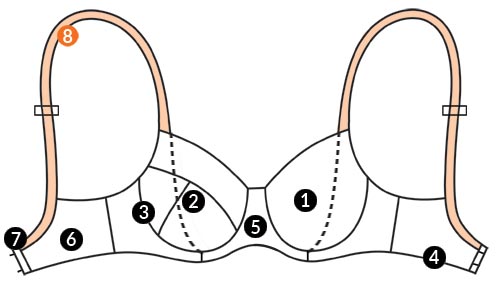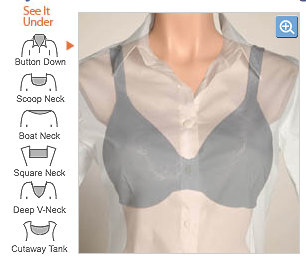Let's take a journey through the next few pages together. Get to the end, and I promise you'll have a better fitting bra size.
HerRoom CEO/Founder
Free Shipping $75+ See Details
Clearance up to 70% Off Shop Now
30% off Value Brands Shop Now
Chantelle: Free Tote Bag* Shop Now
The way a bra is cut, assembled and sewn has a big impact on how it fits your unique shape. In this section we'll dissect each part that goes into a bra and explain its function and how it affects your bra fit.

Bra straps come in many variations. They can be made up of all elastic or have a non-stretch front half with an elastic back half. Bra straps can also be wide, narrow, padded, removable, conjoined, and usually length adjustable. Whatever the style, bra straps are meant to act as stabilizers for the bra. At most, they should carry no more than 10 percent of the breast's weight.
Whatever the style, bra straps should lie flat against your chest (unless you have implants) and not fall off your shoulders. Generally speaking, straps fall off shoulders for these reasons:
If strap slippage is a common problem for you, the trick is to find a bra where the straps are either sewn closer to the center in the front or the back.
You've probably never really noticed how your straps attach to the back of your bra. After reading this, I hope it becomes one of the first things you look at. How the shoulder straps are attached in the back can tell you a lot about how the bra will fit. There are basically two types of strap attachments: camisole and leotard.


The camisole strap attachment style has the straps sewn onto the back at a right angle – creating a box-like shape with the bra back. This strap attachment style has been around the longest and is also used on traditional camisoles and slips. The camisole attachment style works for all bra sizes and is particularly good for larger bra sizes because:
This style also allows for a new back strap adjusting feature known as "kicked in straps," where the back has several tabs along to allow for the straps to be attached either closer or farther away.
The leotard strap attachment is a fairly new design in bras. It has also been called the "U back." Rather than a rectangle shape like the camisole attachment, the leotard attachment gives a round look on the back – like the look of a leotard. It has fast become the most commonly found strap attachment technique in today's ready-to-wear offerings. Recently, some bra manufacturers have been claiming it as their own unique design when in fact, it’s been available for years now. Besides looking different, the leotard back style almost always includes elastic to achieve the rounded shape. This elastic gives the wearer flexibility to raise her arms or bend over without having to adjust her bra afterwards.
There are a few challenges to the leotard strap attachment. The straps attach to the back at a bit of an angle to keep the arch styling. If the "U" shape is too wide, the straps can fall off the wearer's shoulders. Newer "kicked in" back straps help prevent this from happening. The number of back fasteners is also limited with this strap design. But, this style gives a pretty line to your back.
The strap hardware can also impact how a bra strap will fit. Many bra straps have metal or plastic rings on each strap to aid in adjusting the length of your bra straps. When this ring is sewn directly on to either the top of the cup or the bra back, it will allow the strap to swivel to the right or left so that it falls in a more comfortable location for the wearer. If you have sloping shoulders or are prone to having your straps fall off, avoid bras with rings placed in either of these locations.
Speaking of strap hardware – we are often why strap adjusting hardware is almost always in the back rather than the front. After all, if it’s in the front, it would be so much easier to adjust one’s straps correctly. Well, there are several reasons why manufacturers have determined that strap adjusting should be relegated to the back. First, there is the opportunity to have lace or some design detail on the front of the straps to make the bra look more beautiful. This would not be possible if the adjusting was done in the front. Second, depending on your height, the adjusting hardware could end up on the top of your shoulder which could be very uncomfortable. Third, the adjusting hardware can show though form-fitting clothes if in the front. So, for all these reasons, almost all bra straps adjust in the back.
As for how the straps attach to the front of the bra, there are two things to look for. For the best support, the straps should attach directly above the apex or point of each breast. We call this a "center pull" strap. Balconnette and demi-cup have the straps attached closer to the shoulder for two reasons: wider straps will accommodate a wider neckline, and straps attached on the outside of the bra cup create more cleavage by spilling the breast tissue toward the center. If you are prone to having straps fall off your shoulders, you should not select bras with wide-set front straps.

HerRoom is the only lingerie website that shows straight on back and front views for every bra offered. This, along with our exclusive and patented "See it under" feature – where you can see each bra under different necklines – allows you to see how the bra straps on each bra style we offer will work with your clothes.
Find your best bra size
Fast
No measuring tape needed
Let's take a journey through the next few pages together. Get to the end, and I promise you'll have a better fitting bra size.
HerRoom CEO/Founder
Find your best
Bra Styles
By Tomima
You know your bra size. But, do you know your breasts? Sounds like a funny question, but certain bras styles and features work better for some breasts and not for others.
Answer the following questions, and I promise your new bras will make you look younger and thinner!
We are sorry we are unable to assist you further.
